Rocky Mountain Star Stare 2001




Thursday afternoon at Wolf Run there was a stiff warm breeze that settled down nicely a couple hours before sunset. It was mostly cloudy right after sunset; remains of the scattered dissipating thunderheads of the afternoon. It remained mostly cloudy untiil about 10:30 p.m. when holes opened up and it became wonderfully clear and steady. In contrast to our usual fare it was a comfortably warm evening - no long johns or parkas required, though toward the first hours of morning a cool breeze was blowing down the back of my neck, prompting an upturned collar.
From about 11:00 to about 12:30 the seeing was very good. You can always tell when the seeing gets good at star parties - you suddenly notice that everyone is quiet and using their own telescopes. Sort of like in the movies when all the birds get quiet just before the monster or bad guys attack. Mars stood up well in my 8" at 300X, with Mare Sirenum contrasting nicely with the polar cap, and the Hesperia gap between Mare Cimmerium and Mare Tyrrhenum obvious. Mare Boreum highlighted the northern limb, and Utopia was seen to be broken into three or four spots. The double star just to the north of the planet showed crisp but slightly shimmering diffraction rings, and the brighter globular clusters looked like little piles of sparkling sugar on black velvet under a spotlight. Nice.
The views through binoculars of the Milky Way from Sagittarius through Cygnus were awe-inspiring as usual. A bright meteor brought loud exclaimation from the crowd around 12:30 a.m., but unfortunately (and typically), I had my eye stuck to my finder scope's eyepiece at the time and only saw the ground light up with my other eye - too late of course. As the seeing began to soften around 1:00 a.m., I hit the sack to try to conserve a little energy for the following nights. It promised to be a big weekend.
Friday dawned clear and bright. A cool breeze gave way for an hour or so for exceptionally steady views of the sun, which showed many large complex sunspot groups, and was shortly replaced by the typical hot breeze that combines with the sun to dry you out like a prune while hunting daytime planets and talking telescopes with the roving astronomers that happen by while making their rounds of the observing field. There was the usual assortment of wildflowers and bugs and birds to be seen.
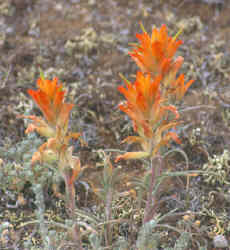

The flowers on the left are Indian Paintbrushes. The bug on the right is Fred. At least that's what I call them. I don't know their proper name, but "Fred" is what my kids named them when they were little and the name stuck. These are large flying beetles with magnificent antennae and are very common in these front range foothills. They can be startling to some folks at first, but they are quite docile and sometimes will hang out on your shoulder for several hours, content to go where you go.
The first afternoon thunder was heard at 1:20 p.m., followed an hour and a half later by rain and some fairly serious lightning which sent everyone scurrying for their Faraday cages (cars and campers). By 5 or 6 the rain had stopped and the clouds were moving swiftly toward the east and dissipating.
As evening set in, the bright crescent moon was seen setting in a darkening sky behind the mountain to the west, and everyone began preparing their scopes for what looked to be a dewy night on the way, but fortunately a slight breeze kept the dew minimized. As the one day old crescent moon slipped behind the western mountain, I heard a large round of applause echo across the field. Not sure what it was about, but I figured there were some serious dark sky types in attendance!
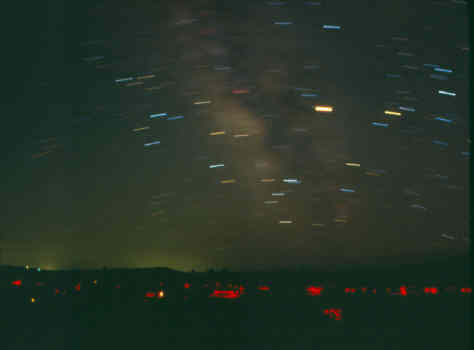
The seeing never really settled down that night, so deep sky objects were the evening's fare, and by 2:00 a.m. high altitude winds were causing the stars in the tail of Scorpius and Sagittarius to wink on and off, and the low clouds hovering over Colorado Springs were beginning to grow, so most folks packed it in for a few hours of sleep.
Saturday dawned a beautiful, sparkling, Rocky Mountain morning, but clouds began building by 10:00 a.m., and a short little sprinkle of rain accompanied by a quick breeze at 11:00 cooled things off for a nice respite from the day's building heat, which returned in full force a half hour later.
The swap meet was about a one hour long feeding frenzy. Fun! There were a lot of good deals to be had, even though (by my standards) it was disappointingly short and small. This is pretty typical for Front Range star parties these days. It seems there just aren't as many do-it-yourselfers as there used to be. With the market flooded by so many inexpensive comercial telescopes and accessories of every description I guess people have more money than time nowadays...
The ATM Walkabout walkers gathered at about 1:30 and walked about the field until about 4:00 p.m..

There were many very beautiful and ingenius homegrown telescopes and accessories to be seen. Offhand I can't remember all the winners in every category, but a few that stick in my mind are breifly described in the photos below. First we see a beatifully machined and anodized equatorial mount for photography made from (among other things) aircraft brake drums, sports car oil filler caps, and dummy Stinger anti-aircraft missiles.

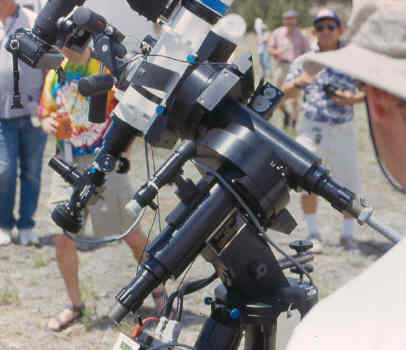
On the left below is a beautiful wooden alt-az truss tube Newtonian with an 18" mirror ground by hand. On the right is a HEAVY DUTY bino-mount for supporting some old (20x80?) Imperial Japanese military binoculars. This mount was made from the steel posts that hold street signs. The head was made of a large lazy-susan bearing and stacks of laminated plywood machined to fit inside PVC pipe for the altitude bearings. The counterweight for this wonderful machine was made up of an assortment of railroad spikes, window weights, and other chunks of iron. I really liked this one.

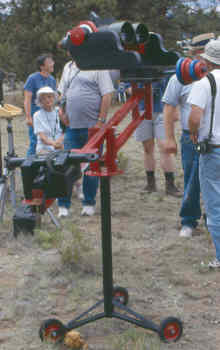
Here is a nice equatorial platform drive for an alt-azimuth Newtonian.

Here is another gorgeous (10"?) wooden alt-az truss fully motorized and computer driven by a small laptop mounted to the top of the accessory stand on the right. The accessory stand is strapped to a hand truck for easy maneuvering, and the laptop has very large letters on the keys. Books, maps, etc. are stored on the bottom shelves.

Here is a (12"?) alt-az Newtonian with a tube made from several slats of wood expertly angled and glued, that can be broken apart into two sections for transport. This beauty featured striking artwork painted on its sides of the first objects seen through it, and a handy eyepiece rack and table integral with the rocker box always within the right hand's reach from the focuser.
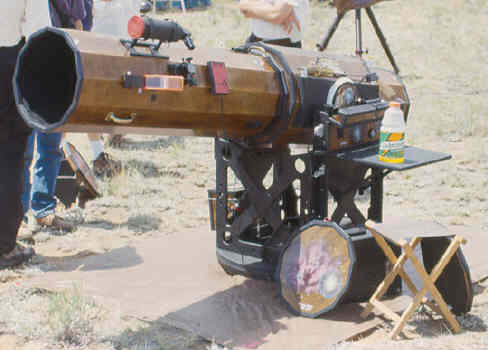
Another winner was this 22" truss tube with integral drive - not sure at this time whether it was azimuth only or if it was of the equatorial table variety.
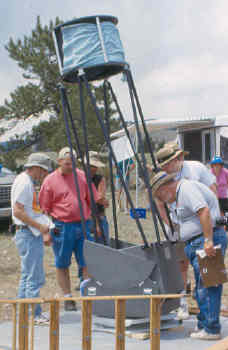

This nice split-ring equatorial Newtonian spends most of its time in a suburban observatory making pictures with a homemade CCD camera complete with liquid cooling. This was definately another award winner. It features a drive made from an old computer floppy drive's head positioning motor which is driven by a tiny control box - about the size of a Wriggley's Plenty-Pak - containing the electronics featuring a chip he programmed to run the motor forward and backward in full, half, and microstepping modes. Nice.
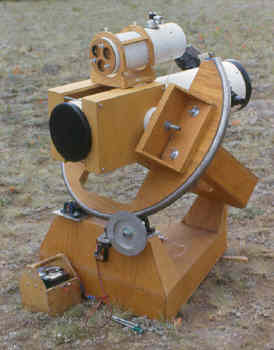
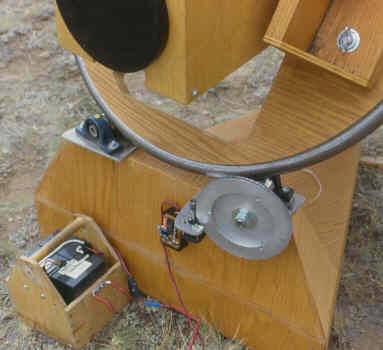
This fellow also demonstrated his star finder made from three telescoping antennas with LEDs that can be spread and extended on a star map, then held up to the sky to find the location of an object in relation to two stars. (I think it got an honorable mention).
In the left photo below is an interesting binocular-supporting easy chair. On the right is an observing stool made by drilling a series of holes along the length of a 2x4, then ripping the 2x4 down its length and putting the halves together to form the adjustment notches for the padded seat.
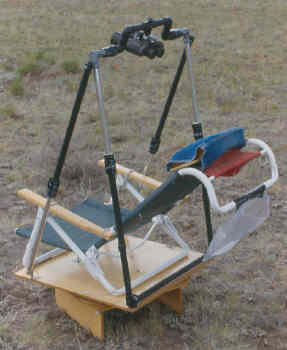
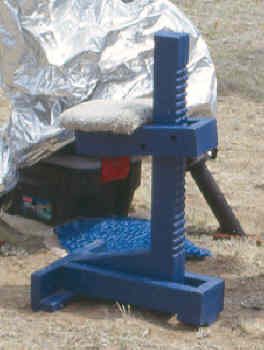
Max and Ray Moe each won awards for Max's dark sky meter and Ray's binomount (and Ray claims he's not an astronomy enthusiast!).
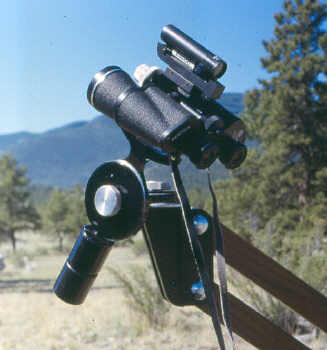
There were many other nice scopes in profusion.
Having set up camp on a south-facing slope to maximise my chances for steady views of Mars and a clear southern horizon, I was pretty distant from most of the action (200 yards or so). I never got to one of the featured speaker's presentations, so I can't comment much on that. I do know that Ben Wentworth brought his tactile planetarium for the blind, which this year consisted of four large dome tents. I believe the NASA braille astronomy book was demonstrated, and a presentation on satellites was given by a fellow from EOSOC (Earth Orbiting Satellite Observer's Club?).
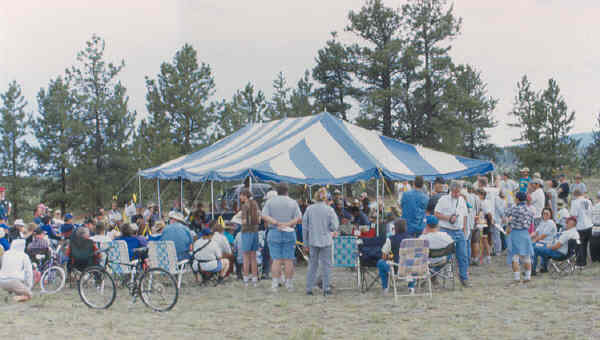
The ever popular door prize give-away was naturally well attended, and starting this year there was a separate telescope raffle just for kids. One smiling young girl made off with what looked like a blue 3.5" f/10 refractor on an alt-az tripod, and another lucky girl walked away with an 80mm Orion short-tube set! Wahoo!!!

Two grown-ups walked off with a 6" equatorial Newt and an 8" alt-az. Pretty good, huh? :)
I had brought enough food to last more than a week, so I missed out on the catered meals again. I heard no report, but I must assume they were great as usual.
In contrast to Friday's wet, chilly evening, Saturday evening was an invigoratingly warm, calm, and summer-like time. There was T-shirt weather till well after sunset! The general mood was very festive, and there were very crisp views of the crescent moon.
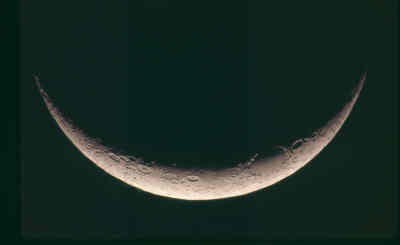
As always under a clear sky at that altitude, within a couple of hours after the sun went down, so did the temperature. I had expected the seeing to improve, and was chomping at the bit to take a shot at spotting Phobos, but it slowly and steadily worsened, getting as bad or worse than Friday night. The sky was quite clear and dark, so I stayed up till about 3:30 when Venus was popping over the eastern hill, and burned a roll of film on deep-sky stuff. By that time most other folks were packing it in as well. Since my drive corrector was on the fritz the photo of M13's field below was taken by hand guiding a 250mm lens.

During most of the weekend, there was a camera crew wandering around the area filming a short documentary to explain why amateur astronomers do what we do, and to capture the feel of a major star party. From what I understand, they were apparently very considerate and used mostly red and infrared light in their filming at night. I made a point of staying at least 90 degrees away from the front of that camera and tended to disappear whenever they were present. When finished, this documentary is likely to air in Denver, Colorado Springs, and Los Angeles.
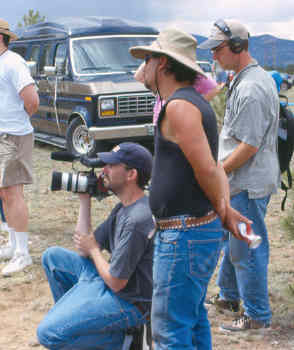
After totaling only 10 or 12 hours of sleep over three nights, I was not looking forward to the drive home Sunday afternoon, but after a short nap and shower I felt pretty good so I took my time packing up and ambled on home. I only saw three or four astronomers that had decided to stay another night. Sure hope the weather held out for them!
Once again the CSAS has put on a great time for astro-nuts and their kin, and I'll give RMSS 2001 a hearty thumbs up. There were people in attendance from Florida to Californina (and Hawaii too, I believe).
Thanks lots guys! I look forward to doing it again next year!